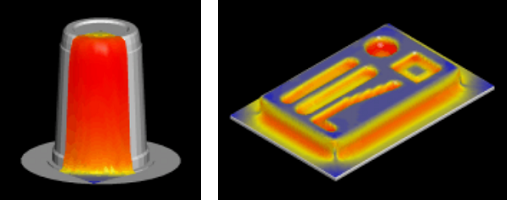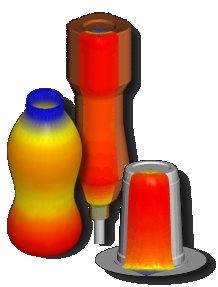|
Why simulate a thermoforming process?
- Reduce the design time for your products.
- No need to perform expensive trial-and-error procedures.
- Select an optimum design from many possible alternatives.
- Get optimum thickness distribution on final product via temperature setup on the sheet.
- Design pre-distorted images for in-mold decoration process.
|
DOWNLOAD PRESENTATION
(7 MBytes)
Verification analysis of a plug
assist thermoformed part
through
computer simulation
Courtesy of Tom Bush,
Fabri-Kal Co., USA
|
Features of T-SIM
- WLF temperature dependency.
- Simulates positive / negative forming with / without plug assistance.
- Time dependent deformation is described by viscoelastic K-BKZ model.
- Three different damping functions for a better material data fit (strain hardening).
- Material database containing PE, PP, PET, PC, PMMA, etc.
- Imports general 3D molds from IGES, VDA-FS via stereolithographic STL file, DXF or Patran Neutral file.
- All molds movable (up to 10 tools can be used in one simulation project)
- Time dependent sheet sagging included.
- Friction between stretched plastic material and tools.
- Heat transfer between material / tools and material / air.
- User-friendly setup of technological parameters with graphic.
- Windows context sensitive help, tutorials and hands-on examples.
- OpenGL included, allowing dynamic image rotation, zooming and panning. This enables fast shading or wireframes and contact visualization options.
- Easy, completely editable setup of T-SIM project for solver. Tight connection between initial project and result files.
- Many typical thermoforming problems solved and distributed on installation CD.
Material
- T-SIM uses time dependent, viscoelastic K-BKZ model.
- Data of frequently used polymers are available in the T-SIM material database.
- Any material can be tested (cooperation with IKP Stuttgart, Germany, or DatapointLabs, USA)
and its data imported into T-SIM.
Solver
- Very fast iterative multithreaded solver gets use of parallel processing on PC with more than one processor.
- Upper limit of sheet elements or mold elements is limited only by PC memory available.
- Fast contact analysis.
- Solving a set of thermoforming problems in a batch mode. This enables automatic case study solution.
Results
- 3D cuts.
- 3D color maps of thickness, temperature, stress, extension.
- Investigate contact between plastic material and molds.
- Easy refinement of the grid in 3D areas of interest from the post-processing window.
- Export results for structural analysis to Ansys, IGES, DXF, Cosmos/M or Patran files.
- Output to Patran format enables structural analysis and calculation of cooling.
- Interactive thickness / temperature / position information with a simple mouse click.
- Export animation file to Microsoft Video Player format.
- Cooling calculation.
Pre-distortion of images (option)
- Prediction of printed image deformation.
- T-SIM is able to pre-distort images for printing them on the flat sheet, so that once thermoformed, the images appear true.
- Image projection manager enables projection of multiple images using various projection methods (planar, cylindrical and spherical projection).
- IGES polylines can be projected, distorted / pre-distorted and exported back to IGES.
- 3D VRML models can be also used for image pre-distortion.
- For more information about image pre-distortion, go to the reference manual.
Customer support
- Support through Accuform representatives worldwide.
- Export of internal T-SIM files for easy data exchange via Internet. This facilitates fast customer support worldwide.
Recommended hardware
- T-SIM delivers peak performance on a multicore Intel or AMD based PC with 2 GB RAM.
- T-SIM runs on Microsoft Windows 7/8/10 - 32/64 bit.
T-SIM users
- T-SIM is used by industry leaders worldwide at Boeing, DOW, Eastman, GE, Mitsubishi, MIT, BMW, Delphi Automotive, Riley Medical, Marconi
Communications, PCM, Fabri-Kal, American Standard, IPS Polymer, Illig, Kiefel, Gabler and many other thermoformers.
T-SIM tutorial online
- Click here to open the T-SIM online tutorial
with more information about T-SIM and with simulation examples.
|




